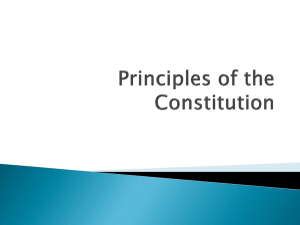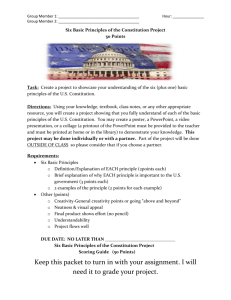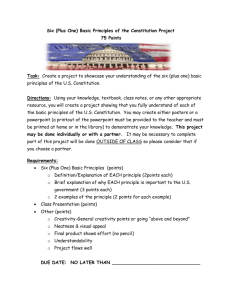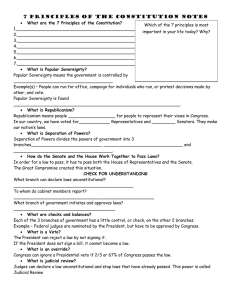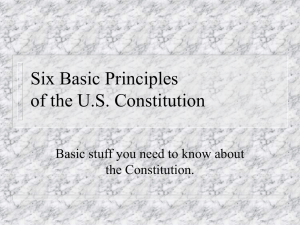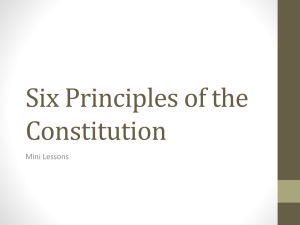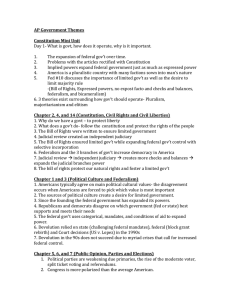Separation of Powers
advertisement
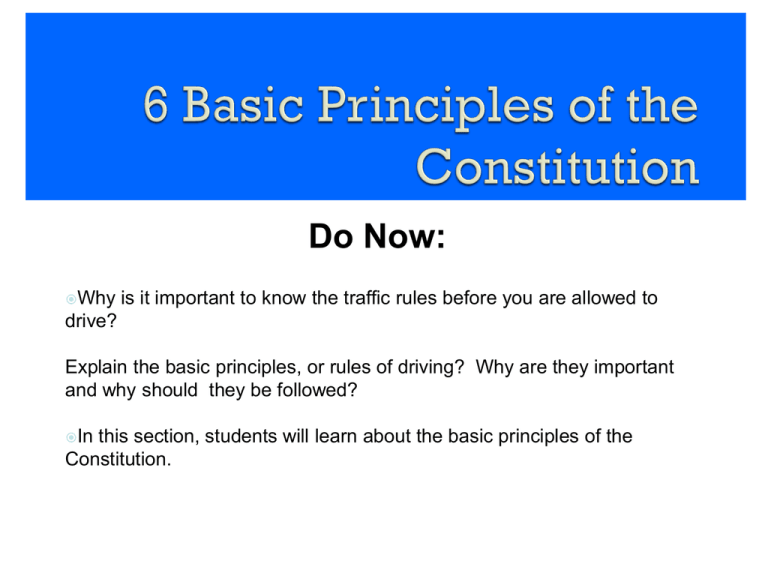
Do Now: Why is it important to know the traffic rules before you are allowed to drive? Explain the basic principles, or rules of driving? Why are they important and why should they be followed? In this section, students will learn about the basic principles of the Constitution. prin·ci·ple a fundamental truth or proposition that serves as the foundation for a system of belief or behavior or for a chain of reasoning. • The Constitution is a fairly brief document, around 4500 words without amendments. This brief document has successfully guided this nation through two centuries of tremendous growth and change. • It begins with a short, noteworthy introduction, the Preamble, and the balance of the original document is divided into seven numbered sections called articles. • • • • • • • • Article 1: Legislative Branch Article 2: Executive Branch Article 3: Judicial Branch Article 4: State Relationships (Federalism) Article 5: Amending the Constitution Article 6: Establishes Constitution as Supreme Law of the Land Article 7: Ratification Requirements 27 Amendments Popular Sovereignty * In the United States, all political power resides in the people. * The people are Sovereign. * Government can govern only with the consent of the governed Limited Government No government is allpowerful, that a government may do only those things that the people have given it the power to do. * Basic American powers are distributed, separated among 3 distinct and independent branches of Government. * The Constitution distributes the powers of the National Government among the Congress (the legislative branch), the President (the executive branch), and the courts (the judicial branch). Separation of Powers Checks and Balances * Each branch is subject to a number of constitutional checks (restraints) by the other branches. * In other words, each branch has certain powers with which it can check the operations of the other two Judicial Review * The power of courts to determine whether what government does is in accord with what the Constitution provides. * It is the power of a court to determine the constitutionality of a governmental action. Marbury v. Madison (1803) Federalism The division of power among a central government and several regional governments. In groups, identify the following 6 basic principles in the constitution. List by Article, section and paragraph. You must have at least two per principle. • Popular Sovereignty- Authority is created by the consent of the governed • Limited Government- Authority is limited by written rules • Separation of Powers- Separate entities within government that struggle against each other • Checks and Balances- Explicit rules which allow branches of government to control each other’s power • Judicial Review- The power of the judicial branch to declare acts unconstitutional • Federalism- States and National government share power • Assign the class into groups of 6. Each person in the group will look in the book to define one of the six basic principles. Provide each group with 5-6 index cards. Have group members write the definition of their principle on one card, and examples of the principle or terms associated with it on the rest of the cards. Put what principle it is on the back. Cards from all of the groups should be placed in a box and shuffled. After the teacher has listed the six principles on the whiteboard, students should alternate turns picking a card and placing it under the appropriate principle on the board. Groups earn one point for each member’s correct response. Name: _________________ U.S. Government Date: ___________________ Mr. Cavazos Period: ______________ Judicial Review Checks & Balances Federalism Separation of Powers Popular Sovereignty Limited Government • Translate the Preamble to the Constitution into today’s common language. Hint: Try breaking the text into chunks or phrases and focus on one at a time. • Underline any words that you don’t know what they mean/are not comfortable with.
